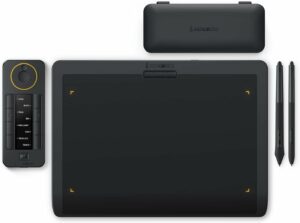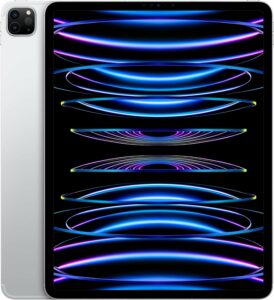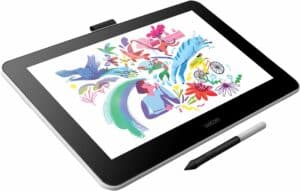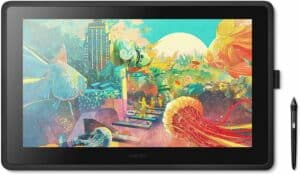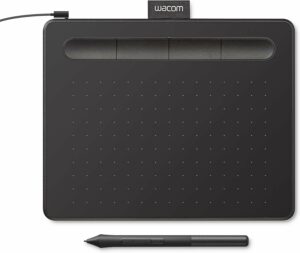Best drawing tablet in 2025 – our top picks
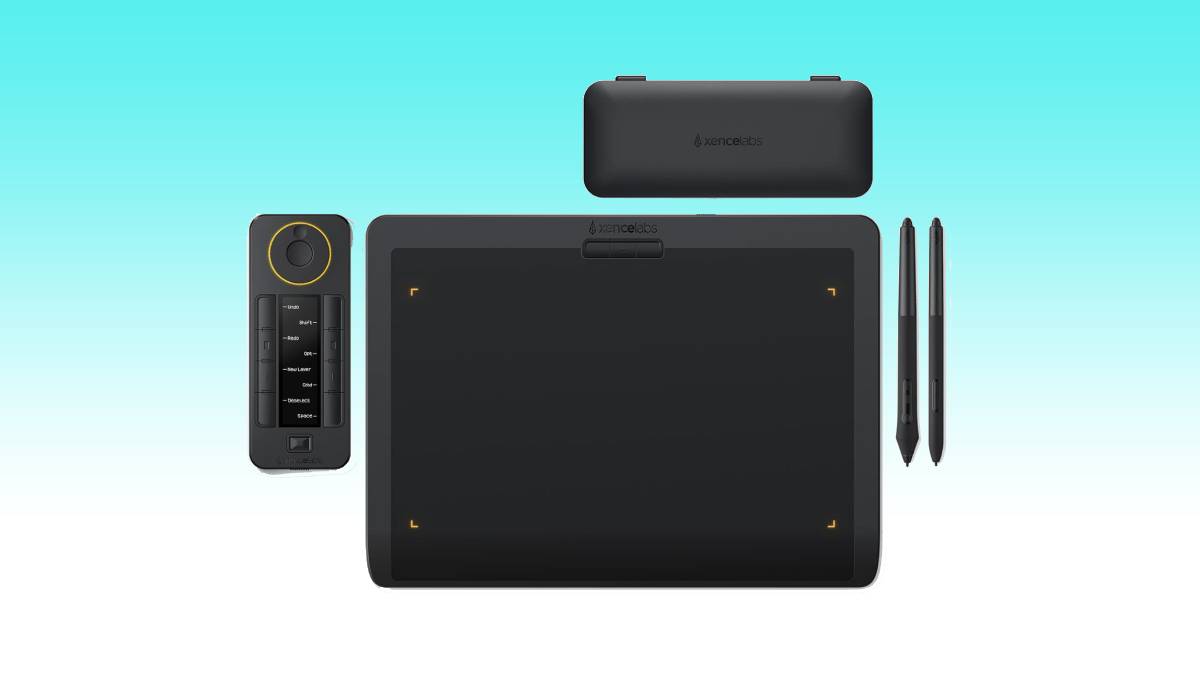
Table of Contents
If you’re looking for the best drawing tablet, we have you covered right here.
Primarily, there are three types of drawing tablets – regular tablets, standalone tablets, and pen tablets. Some regular tablets, like the Apple iPad Pro, deliver good performance for digital illustrations and support an active stylus pen (i.e., Apple Pencil). Next, you can think of standalone tablets as an all-in-one device that doesn’t need you to connect to any other external device for drawing. Then, you have the basic drawing tablets that come with a pressure-sensitive surface instead of a screen.
Depending on your preferences and budget, you can choose a tablet that best suits your needs. To give you a better idea, the basic pen tablet with basic features is the most affordable option. The standalone tablets cost a bit more than the basic drawing tablets, and more if they come with professional features. Meanwhile, regular tablets with good stylus pens can vary in price, depending on the features.
With that being said, there are many drawing tablets out there in the market that can meet your requirements. To help you choose the best option possible, we have compiled a list of drawing tablets.
Products at a Glance
How we picked
For this guide, we have researched several drawing tablets, compared them, and selected the ones we thought were the best. The tablets have been selected based on specs like display, portability, performance, support for peripherals, and more. We’re always on the lookout for new products to add to our guides and keep them updated – so check back here for more.
Product Reviews
- 10.3-inch active area
- 8192 levels of pressure sensitivity
- Lightweight and portable
- May not be suitable for beginners
If you are looking for a professional tablet for drawing, then you should check out the XENCELABS Wireless Drawing Tablet.
The tablet comes with a 12-inch pad, which should be spacious enough for most artists. However, you should note that you get only a 10.3-inch active area. Further, the display gives you a 16:9 aspect ratio, which matches industry standard displays. Plus, as the tablet works with Mac, Windows, and even Linux, so you should have no trouble connecting it to your computer.
As far as drawing is concerned, the tablet offers up to 8192 levels of pressure sensitivity, which should let you use different strokes and textures for a richer finish. You get two stylus pens – a thin one and a thicker one, so you can choose as per your preference. Another noteworthy feature here is that the pens are battery-free, so you don’t have to worry about
To make your workflow effortless and more convenient, the tablet comes with built-in buttons that you can customize for your favorite shortcuts. Further, the device has a slight slope that promises to prevent hand fatigue during long drawing sessions.
As far as portability is concerned, the device weighs only 1.9 pounds, which is portable for most people. However, note that you will also have to carry the dial and stylus pens along with the tablet.
- 12.9-inch Liquid Retina XDR display
- Powerful M2 chip
- All-day battery
- Expensive
If you want an absolute powerhouse for your creations, then you should check out the Apple iPad Pro (6th gen). In fact, we think it’s powerful enough to be one of the best tablets for photo editing.
To start with, the iPad comes equipped with a powerful M2 chip that has a 10-core GPU and an 8-core CPU. You can expect this chip to handle demanding tasks like drawing illustrations, editing, and more.
On the outside, the iPad Pro sports a large 12.9-inch Liquid Retina XDR display, which boasts high brightness levels and vibrant colors. The display offers a P3 wide color gamut, which means you get a broader range of colors to work with and higher color accuracy.
Now, let’s take a look at the actual drawing experience. To start with, the display offers a 120Hz refresh rate, which should let you draw with precise strokes and precision. Further, you get to draw with the Apple Pencil, which has to be brought separately. Another notable perk here is that you get to use exclusive apps like Procreate and Adobe Fresco, which should help make your workflow seamless.
If you have to carry your tablet around, then you’d be happy to know that the iPad weighs only 1.5 pounds – which is surprisingly light, considering the screen size. Plus, you get an all-day battery life, so you can work uninterrupted.
- Spacious 13.3-inch screen
- Battery-free stylus pen
- Single cable setup
- Slightly heavy
If you’re a beginner looking to explore digital artistry, then the Wacom One tablet would be a good starting point.
The tablet comes with a spacious 13.3-inch screen, which should be sufficient for artists to draw, sketch, and even edit content. Plus, the display has an anti-glare coating, which should give you a comfortable viewing experience.
Coming to the actual drawing experience, the tablet comes with a battery-free stylus pen, so you don’t need to worry about running out of juice. Plus, the pen offers pressure sensitivity and tilt recognition, which should give you a professional drawing experience. With Wacom, you also get access to software like Clip Studio Paint and Bamboo Paper, which might come in handy.
Further, the device offers a hassle-free setup and use – all you have to do is use the single cable system to get started. Plus, the Wacom tablet is compatible with Mac, PC, and ChromeOS, so integration should not be a problem.
As far as portability is concerned, the device weighs 4.4 pounds, which is portable – but not as lightweight as some other options on this list. However, you can decide to get the optional stand for more convenience.
- Large 22-inch screen
- Anti-glare surface
- Customizable buttons
- Comparatively expensive
If you’re looking for a standalone, professional-grade drawing tablet, then you should check out the Wacom Cintiq 22.
To start with, you get a huge 22-inch screen, which is bigger than some of the best large-screen tablets – so you will have sufficient screen space for your artwork. Further, the tablet has an anti-glare surface that should reduce eye strain and minimize distractions.
For drawing, the tablet offers the Wacom Pro Pen 2, which promises a lag-free experience and the feel of a real-life pen on paper. Plus, it has 8,192 levels of pressure sensitivity and tilt recognition, so you can expect a professional experience.
To make your workflow easier, the tablet also features ExpressKeys, a Radial menu, and a Touch ring – all of which help you add customized shortcuts for better navigation. For ergonomic comfort, the tablet comes with a built-in stand that you can use to angle the device as per your preference.
- Battery-free stylus pen
- 4,096 pressure sensitivity levels
- Training and software included
- Limited features
If you are just dipping your toes into digital drawing, then you should check out the Wacom Intuos tablet, which comes with training software.
To start with, it is a drawing tablet without a screen, so you get a 5.98-inch x 3.74-inch active surface area to work on. As you can see, it is a rather small tablet meant for beginners, so it is quite compact and comes with a beginner-friendly setup.
Coming to the actual drawing experience, the tablet offers 4,096 pressure sensitivity levels, which should be suitable for beginners and enthusiasts. The stylus pen feels like a regular pen and is battery-free, so you can draw as you would on regular paper. Plus, as mentioned earlier, the tablet offers training lessons and software, which are built into it, which should come in handy.
As far as your workflow is concerned, the tablet works with Mac, Windows, Android, and even ChromeOS. Plus, you get customizable ExpressKeys that you can set up with preferred shortcuts for quick access.
How to pick the best drawing tablet
Here are a few things to consider while buying a drawing tablet –
Display
When it comes to display, the goal is to get a screen size that is comfortably big for drawing and also delivers high-quality visuals. For instance, an 11-inch screen is large enough for you to draw, while a 10-inch screen will be lighter and more travel-friendly. Further, you should look for at least 1080p resolution to get good picture quality for your creations.
Performance
Now, to make sure that you get a smooth, lag-free performance, you should look for a powerful processor (like an octa-core processor) – especially for animation or 3D work. Further, you should also have adequate memory to enhance performance – look for at least 8GB of RAM.
Another feature to consider is pressure sensitivity – the more the pressure points, the more details you can add. For instance, if there are 8192 pressure points, you would be able to add shades, strokes, and more details.
Portability
As you will be drawing with one hand and holding the device in another, you should look for a lightweight device. Ideally, a drawing tablet should weigh about 2 pounds less than that for comfortable on-the-go creativity.
Another feature you should consider is battey life. For you to get the most out of your tablet, the device should at least deliver 8 to 10 hours of battery life.
Support for peripherals
The most important accessory that you will probably be using is a stylus pen. Most tablets for drawing come with an “official” stylus that you can use to draw. Further, some tablets also offer support for detachable keyboards, which you can consider including in your kit, depending on your workflow.
Our Verdict
If you want to get the absolute best tablet for drawing, then we’d suggest getting the XENCELABS drawing tablet. The tablet is specially designed for drawing, and it promises to offer a natural, customizable, and portable drawing experience. The tablet offers spacious screen space for working, 8192 levels of pressure sensitivity, and two stylus pens. Further, you get built-in customizable buttons for adding shortcuts, as well as other features to make your workflow more seamless. Overall, if you’re an illustrator looking to get a professional pen tablet, then this device is a good investment.


